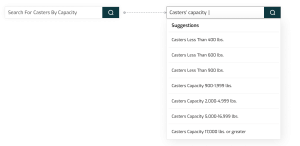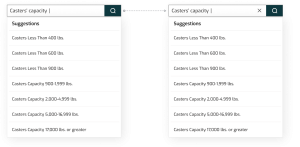July 22 2024
Optimize Your E-commerce Search UX for Conversions
In the competitive world of e-commerce, every click counts. Did you know that 30% of e-commerce visitors use the search bar, and these users are twice as likely to convert? A well-designed website attracts customers, but a flawless search experience is the key to converting them into loyal buyers. It’s the little things – the micro-improvements to your search bar – that can have a massive impact on conversion rates.
This guide delves into the world of e-commerce search UX (user experience), providing actionable insights on how to optimize your search bar for increased user satisfaction and boosted conversions.
Let’s take an example of one of our clients, CasterConcepts.com.
Their previous search design –

1. Make the Search Bar Prominent: Increase Its Width
A cramped search bar can feel restrictive and hinder user interaction.
Solution: Increase the width of your search bar. This creates a more prominent and inviting search area, improving user experience and encouraging interaction.

“During our usability testing the users adopted search as their primary product finding strategy much more frequently on sites that had a very prominent search field” – Baymard Institute
2. Match User Expectations: Use Clear Submit Buttons
Many users instinctively look for a button to initiate a search. A traditional search icon can lead to confusion.
Solution: Replace the search icon with a clear and labeled submit button. This aligns with user expectations and streamlines the search process.
“A group of users won’t look towards keyboard when trying to submit their query.” – Baymard Institute (Link)
3. Guide Users: Use Effective Placeholder Text
Users might not know what keywords to search for, leading to irrelevant queries.
Solution: Utilize placeholder text within the search bar. This improves search clarity and reduces irrelevant queries.

Anytime I see a search bar that just says “Search,” I see a missed opportunity. Clue your users into the fact that they can search in multiple ways, especially if they may not be familiar with your full range of products. – Smashing magzine
4. Enhance Engagement: Integrate Microinteractions
A static search bar lacks engagement. Users might miss advanced search options.
Solution: Integrate subtle microinteractions. These can be animations or visual cues that grab user attention, provide feedback, and subtly nudge users towards desired actions, such as using advanced search filters.
Have you ever given someone a nudge in the right direction? People tend to make decisions unconsciously. A nudge helps redirect them toward a better one.. – Delve
5. Speed Up Searches: Implement Real-Time Suggestions
Time-pressed users might abandon their search if it’s too slow or irrelevant.
Solution: Display relevant search suggestions as users type. This expedites their search journey and introduces them to potential product categories or keywords they might not have considered.

In our recent study on websites, suggested queries were selected by users in only 23% of the instances where they were offered. – nngroup.com
6. Simplify Actions: Provide Easy Query Removal
Frustration builds when users can’t easily erase their entire search query.
Solution: Emphasize user-friendliness with a clear “X” icon. This allows users to easily remove the entire search query with a single click, eliminating unnecessary backspacing.

Bonus Tips for a Winning Search Experience
– Ensure Accessibility: Make your search bar accessible for users with disabilities by incorporating proper color contrast and screen reader compatibility. Consider following the [WCAG accessibility guidelines](https://www.w3.org/WAI/standards-guidelines/).
– Leverage Power of AI: Integrate AI-powered search solutions that analyze user behavior and search patterns, refining search suggestions and delivering hyper-relevant results that convert.
– A/B Testing : Don’t be afraid to experiment! Utilize A/B testing to compare different search bar designs and functionalities. This data-driven approach helps you identify what resonates most with your users.

By implementing these micro-improvements and considering AI-powered solutions, you can craft a search UX that delights users and drives conversions. A seamless and intuitive search experience is the cornerstone of e-commerce success.
Kray’s Latest articles, right in your inbox
Pick up the topics you are the most interested in, we take care of the rest


